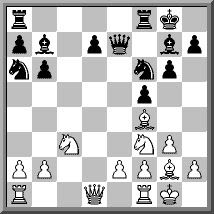Hera - Gajewski, Oberwart 2007
1.d4 f5
The Dutch is Black's most unbalancing reply to the closed games.
2.g3 Nf6 3.Bg2 g6
This is the Leningrad variation which is one of Black's most dynamic lines within the Dutch complex. 3...e6, leading to the Classical Dutch or the Stonewall is a more solid option.
4.Nf3 Bg7 5.0–0 0–0 6.c4 c6!? (Dia)
6...d6 is by far Black's most popular option at this point. Then, after 7.Nc3, 7...Qe8 is now Black's most popular line, but 7...c6 is still frequently played. One of the ideas behind the game move is to set up a kind of stonewall with pawns on c6, d5 and f5 (and eventually e6, but usually only after bringing the light-squared bishop via e6 to f7). But White also must take into account that Black can return to a more standard Leningrad set-up with ...d6 as long as he keeps playing flexible moves like ...Na6, ...a5, ...Kh8 etc. There are also lines with ...Ne4 and ...Qe8 which may transpose to standard Leningrad lines. One of Black's more independent ideas is an early ...Qb6.
7.Nc3
This is White's most natural continuation but 7.b3 and 7.b4 are important alternatives to which I may return in a later entry.
7...Na6!?
I like this move which is an attempt to keep White guessing about Black's intentions. It's still possible to play ...d6 with a relatively normal looking Leningrad position. Black's most frequent choice is 7...d6 immediately returning to the 6...d6 7.Nc3 c6 line. The direct 7...d5 reveals Black's plans too early for my taste but 7...Ne4!? is another flexible approach.
8.d5!?
This stops Black's ...d5 plans but doesn't appear very logical when there is no weakness on e6 to clamp down on.
8...cxd5
9.cxd5 b6 10.d6 Bb7 11.dxe7 Qxe7 12.Bf4
Black is active but White obviously has got the better pawn structure and probably is somewhat better.
12...Ne4!?
Is this an intentional exchange sacrifice? 12...d5 is an obvious alternative and doesn't look too bad.
13.Nxe4 fxe4 14.Bd6 Qf6 15.Qb3+
If White wants to win that exchange it may be better to do it right away as 15.Bxf8 Rxf8 16.Nd2 Qxb2?! (16...d5 17.Rb1) can be met with 17.Nxe4!, threatening Nf6+ when Black may not have anything better than 17...Kh8 anyway (17...Qxa1?? 18.Qb3+ loses immediately).
15...Kh8 16.Be5?!
16...Qe7 17.Bxg7+ Qxg7 18.Nd2 d5 (Dia)
19.Rad1 Rac8 20.Nb1 Rc4 21.Qa3 Nc5 22.b3 Rc2
It's hard to suggest improvements for White but it's obvious that his position has worsened during the last few moves.
23.Qxa7?
Now the queen will find herself in trouble. After 23.b4 Ne6 24.Qxa7 Nd4 25.Qxb6 Nxe2+ 26.Kh1 Rxa2 Black must be somewhat better thanks to his center pawns but it's not obvious how he should continue.
23...Qf6
The game is decided. 31.Qc3 Bxe4 32.Qc8+ Kg7 33.Qxa6 Bd5 is just as bad.



No comments:
Post a Comment